Handball drills
- This is best restricted to inside the 6 meters area.
- This game is best played with the same number of players in both teams.
- Make it harder by making the play between the 6 and 9 meters and the defenders can only do side step/shuffle Objective of the game:
- get the youth used to contact in handball Divide the players in two teams with roughly equal numbers and abilities (don't put all the big and good players in one team and the rest in the other)
- The players play the 10 pass game.
- No passbacks allowed.
- The defending team will try to stop the attacking team by placing 2 hands on their chest and arm and holding (measure the level of aggressiveness and adjust).
- If they are successful it's a turnover.
- Then start over with the same rules.
- Make it harder by instead of being two hands, being a tactical defence hug and holding 3 seconds.
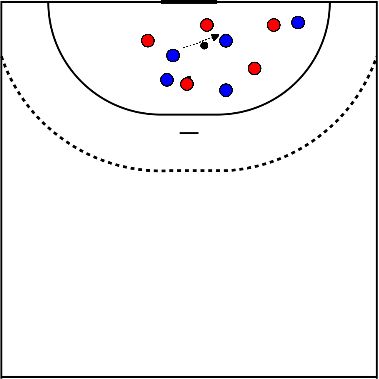
This is a coordinated minus tempo attack to create a lot of space on the wings and shoot freely.
- The back players rotate the ball wing to wing to displace the defenders.
- When the play gets called "Minus tempo Left/Right" this means it will be the left or the right winger to shoot.
- If the call is Minus tempo right, then it will be the right winger to shoot, as in the example below.
- The first step is the pivot places themselves on the 3 defender, near the left back, displacing the central defenders slightly to their right already.
- The right winger then goes deep to near the corner flag to open up as much as possible.
- The left back passes to the left wing, who passes back to the left back, passing to the centre, to the right back, to the centre back again, back to left back, and back to left wing. All these passes will create space by themselves.
- Once the ball leaves the left wing again, the left back makes a run to goal with the ball attacking between 2 and 3, the centre back does the same attacking around the other 3, and the right back as well attacking between 2 and 1, closer to 2.
- These runs have to be coordinated to displace all defenders. This will make it so the defenders 1 and 2 on the right side will close on the right back, and the wing will be free.
- The left back then jumps and passes across the court to the free winger who has started running and has enough momentum and angle to score.
- If the defenders don't move then there's several other finishing options. If the second 3 defender doesn't close the pivot, the pivot will be free.
- If the second 3 closes the pivot, but the 2 defender doesn't close on the centre back run, then the centre can score. If the 2 defender closes but the 1 defender doesn't close, then the right back scores.
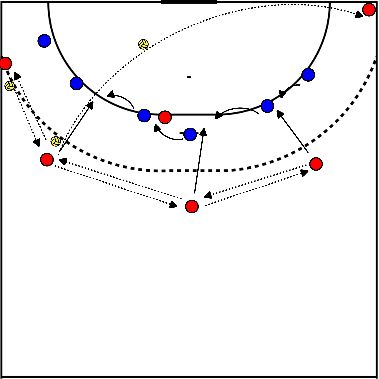
This can make use of an existing outline of a badminton field's lines, or be created with cones.
This serves 3 purposes:
This serves 3 purposes:
- Passing
- Moving to receive the ball
- Defense
- You will need 3 pairs of players.
- Two pairs on opposite ends of the delimited area trying to pass the ball to each other, and one pair in the middle intercepting.
- The pairs on each end, can not pass to their partner, they have to pass to the other pair at the other side of the court.
- They can not pass the centre point.
- The defending pair will either try to touch the person with the ball, or to intercept the pass.
- Once the defending team succeeds in one of these, then they swap.
- If the pass is out of bounds, they also swap.
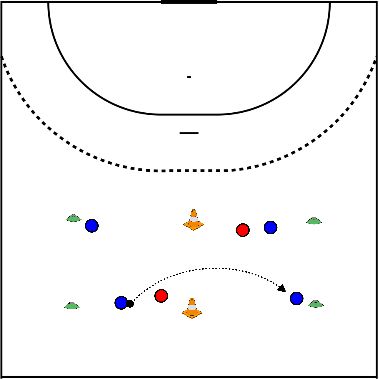
This is a resistance and mental strength exercise.
- Each player goes to their position. They will have to take 3 - 5 shots in a row, running back to the position as soon as they shoot. For every two shots, they will have to change the third shot.
- The objective, more than building resistance, is to build mental strength to make the body go forward when we're tired.
- This will be repeated several times.
- The first couple of times the players won't be tired, but after the third or fourth repetition of the series of shots in a row, then they will.
- There can also be one player (pivot for example) blocking shots (not 100% defense, just 30%)
- If the overall team scores more than 50% than the keeper does 20 push ups, 20 sit ups, and 20 squats.
- If the team scores less than, then the team does it.
- Make 6 or 8 columns of players (at least 2 in each column).
- They will have 2 balls in play, with some time distance. (wait until the first ball reaches the middle point and then the second ball starts being passed around)
- The players will have to pass the ball and run to the column they just passed the ball to.
- They will have to be running when they pass the ball, and change passes after a while (normal, bounce, side, underarm,...)
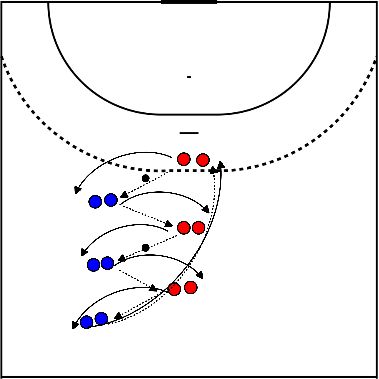
2 and 2 and 3 balls per group
- Start with 3 balls per group. 1 ball on the ground and played back and forth with the feet, while the other 2 are passed back and forth. Never hold the balls in hands for more than 1 second, always pass back immediately. Don't be nice to your partner, challenge them.
- Then have 2 balls, with 1 player holding the ball in hand. Throw the ball up and while it's in the air, pass the other ball back and forth once. Make it harder by trying to pass 2, then 3, then 4, then 5 times while the ball is in the air.
- 2 balls per group - 1 player starts with both balls. Throw 1 high ball and during that time, quickly pass the other ball. The second ball should be caught before the high ball is caught. Add the challenge of passing the quick ball back.
- 3 balls per group - 1 player starts with all the balls. Throw them in an arc, one by one. All 3 balls should be in the air at the same time and then caught by the receiver.
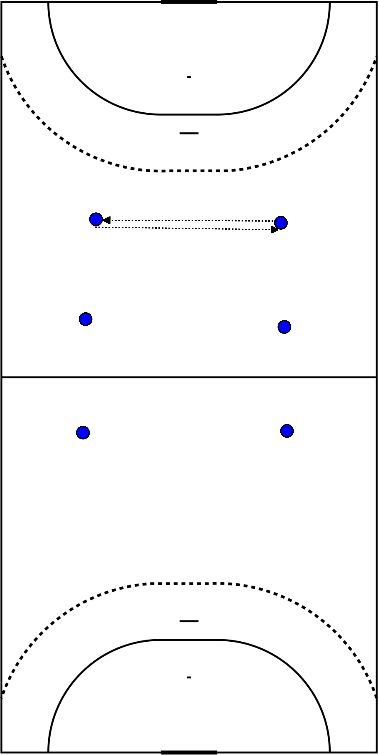
The players form a line at one end of the court.
- The 2nd player on the line passes the ball to the coach who will be between the centre of the court and the 12 meters.
- The 1st player on the line runs as soon as the pass is made.
- The coach will then pass the ball to the front of the 1st player who is running towards the opposite goal to receive the ball.
- The pass will not be towards the player's hands, but rather to a step in front of where they are, so they continue accelerating.
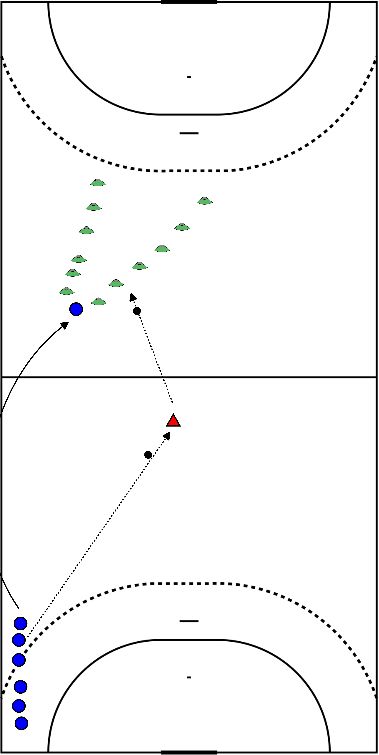
- This can be done with groups of 5 up to 9.
- Let's take a group of 7
- Delineate an area where 4 people can stand and move around with a bit (not too much) room. Place 3 defenders inside, plus 1 line/pivot.
- The remaining 3 attackers will pass the ball around outside the area, with no bounce, and they score a point by either:
- Passing the ball effectively to the pivot
- Placing the ball inside the area without being touched by a defender
- The attackers can move freely, but limited to the 3 steps, 3 seconds with ball in hand, and no bounce.
- If these rules are broken, they become the defenders.
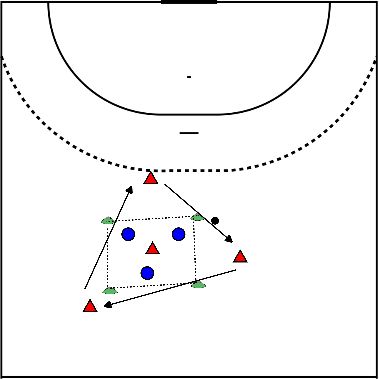
This can be done with groups of 3 to 7 - odd numbers ideally.
- Let's assume a group of 5 players.
- We'll have 3 attackers and 2 defenders.
- The 3 attackers will have a delimited running corridor in a straight line and they will have to pass the ball from one to the others while the 2 defenders will have to try and intercept the passes. The defenders have freedom of movement.
- The exercise can evolve in the types of passes in order to foster movement without the ball.
- First all types of pass, then no lob passes, then only bounce passes.
If the defenders intercept the pass, they continue the exercise acting as the attacking players in numerical inferiority. The 3 attacking players now have no restriction of movement.
This is to be done slowly at first, not as a fast break, to instill the idea of moving without the ball first. The speed can be adapted as the exercise goes on.
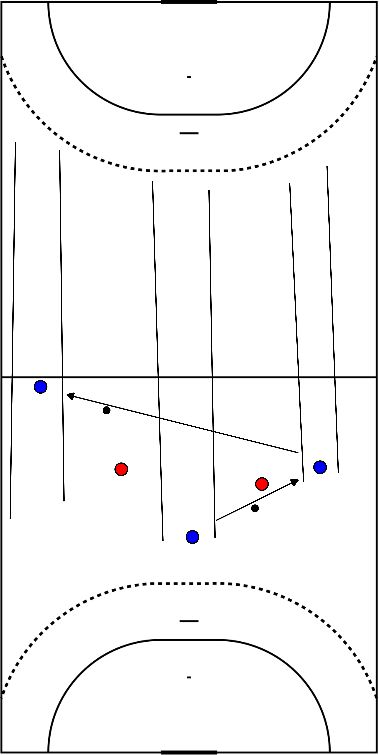
- Make 4 compartments (size depends on the size of the team)
- Everyone starts tipping in box 1
- If you tip the ball away from someone else, you may move up one square.
- Winner is the first to leave the last box
- Little 8 is the change of circle with the corner players.
- Middle build-up indicates which system is started. At small 8 the corners and circle start running;
- The right corner takes the initiative and runs towards the position of the circle (can be with or without ball!), the circle runs towards the corner and perhaps takes a defender with it. This may free up the circle which can be played through the build-up. If not, the substitute moves on to the other corner, until either a goal is scored or everyone is back in his/her own place.
- Important is watching each other's timing, not getting in each other's way and correct passing with bounce by the builder.
- Practice start with passive defenders, then active
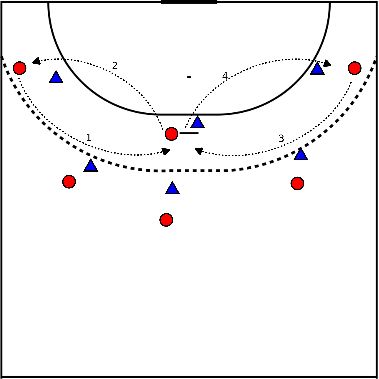
Divide team into 3 teams.
- Team 1 starts defending
- Team 2 starts attacking from the middle
- Team 3 gets ready on the middle line with ball
Once completed, team 2 starts defending and the 3rd team starts attacking from the middle.
- Team 1 takes the ball and gets ready on the middle line, etc.
The goal is to switch quickly from attacking to defending.








